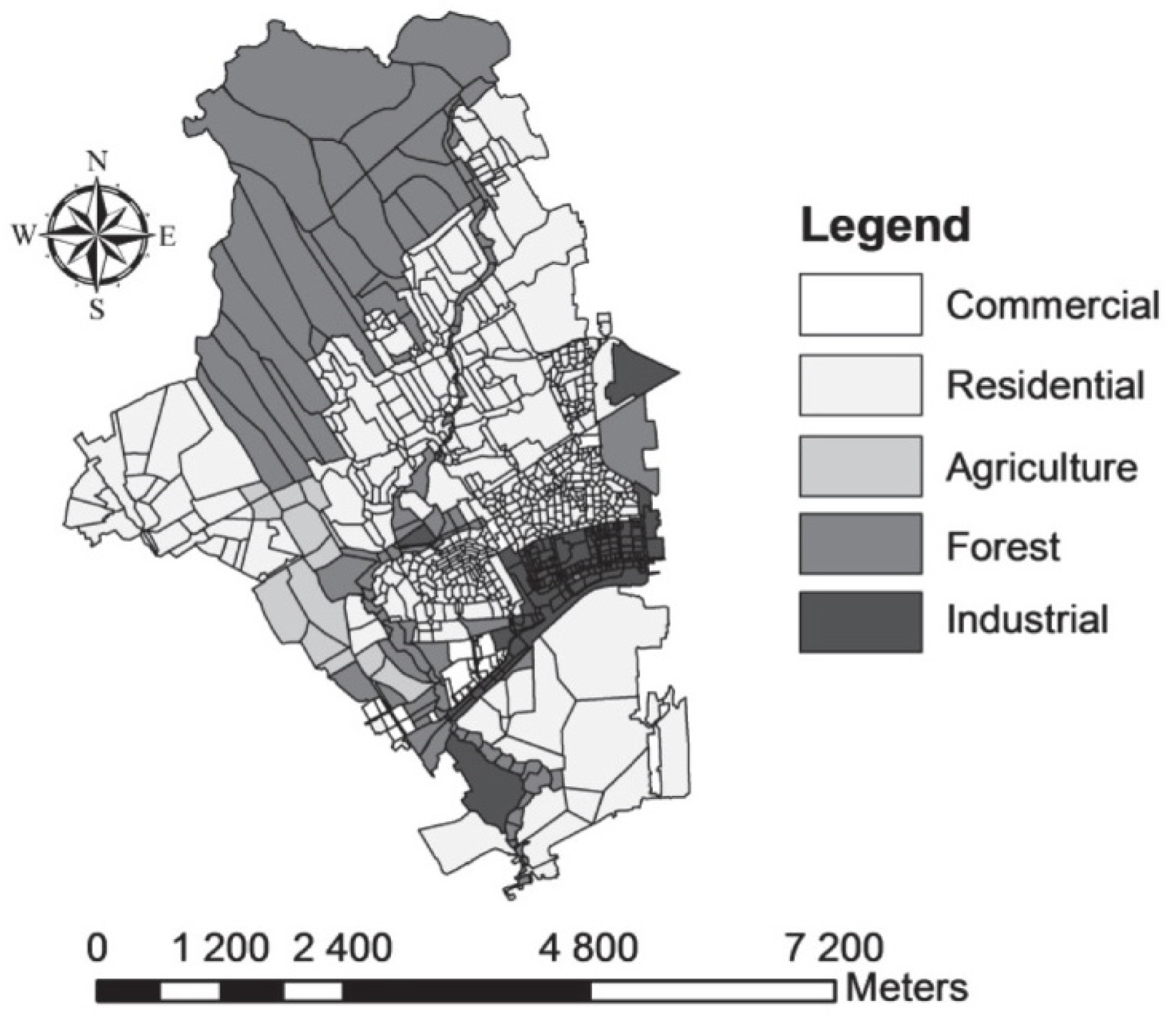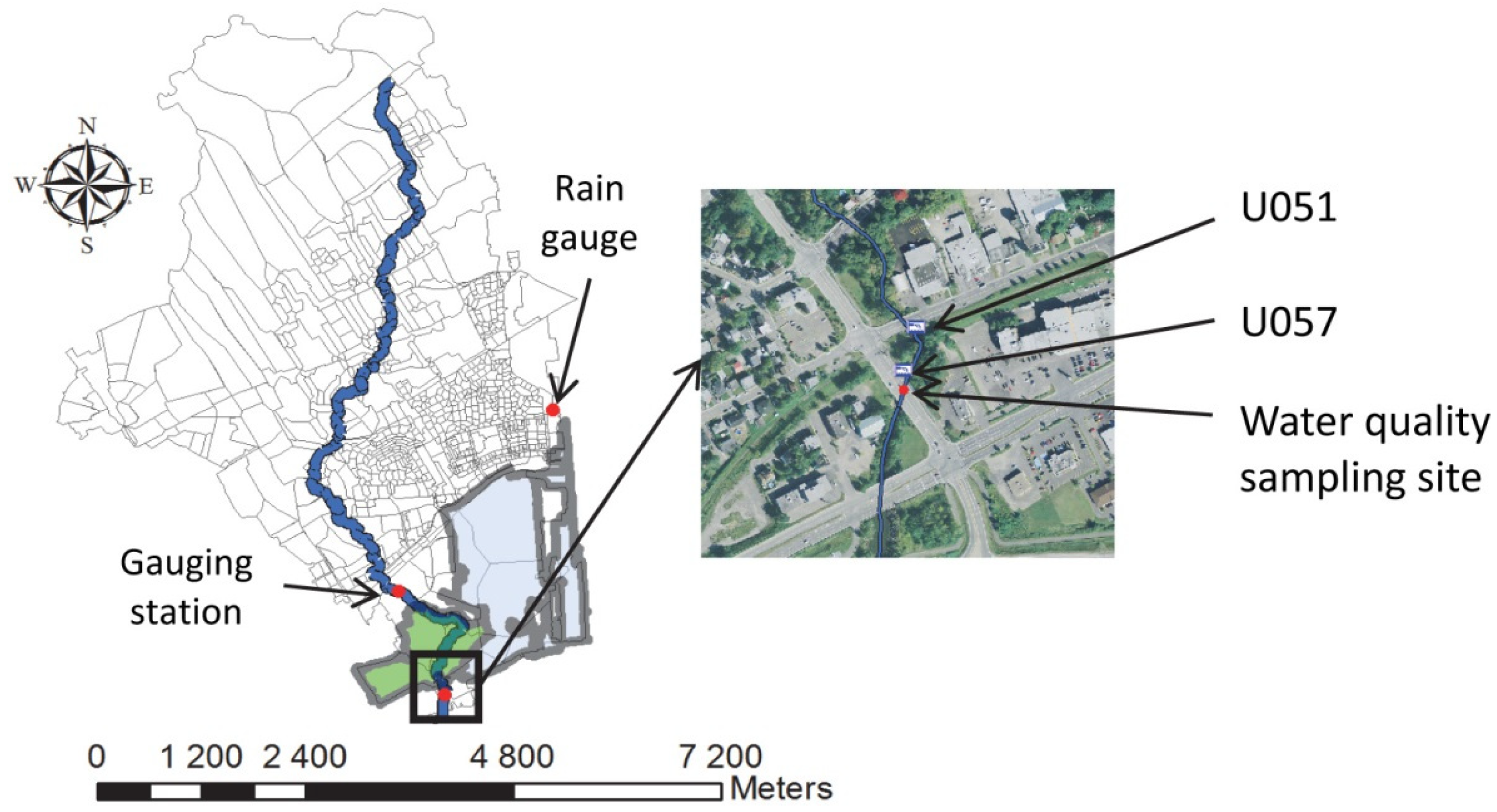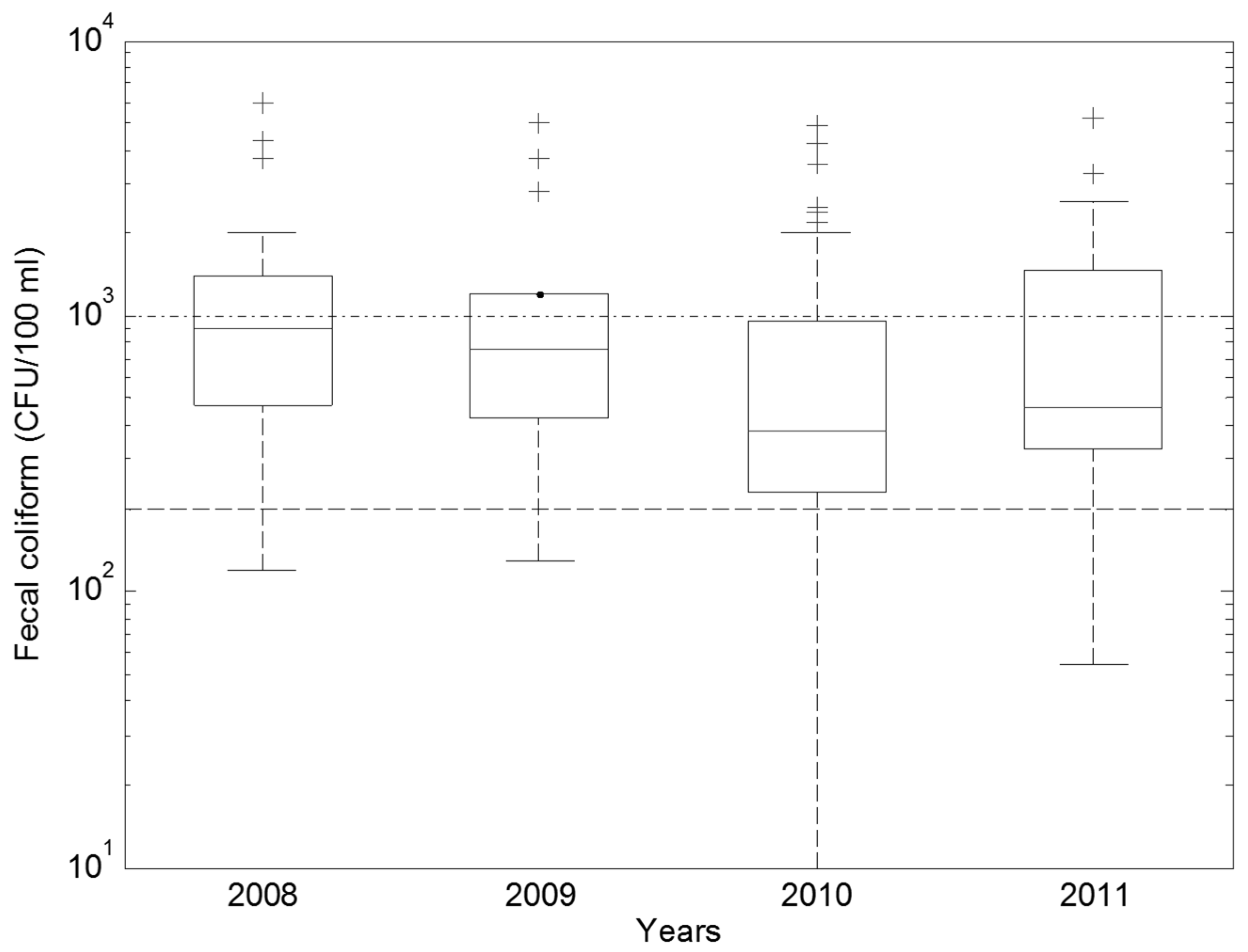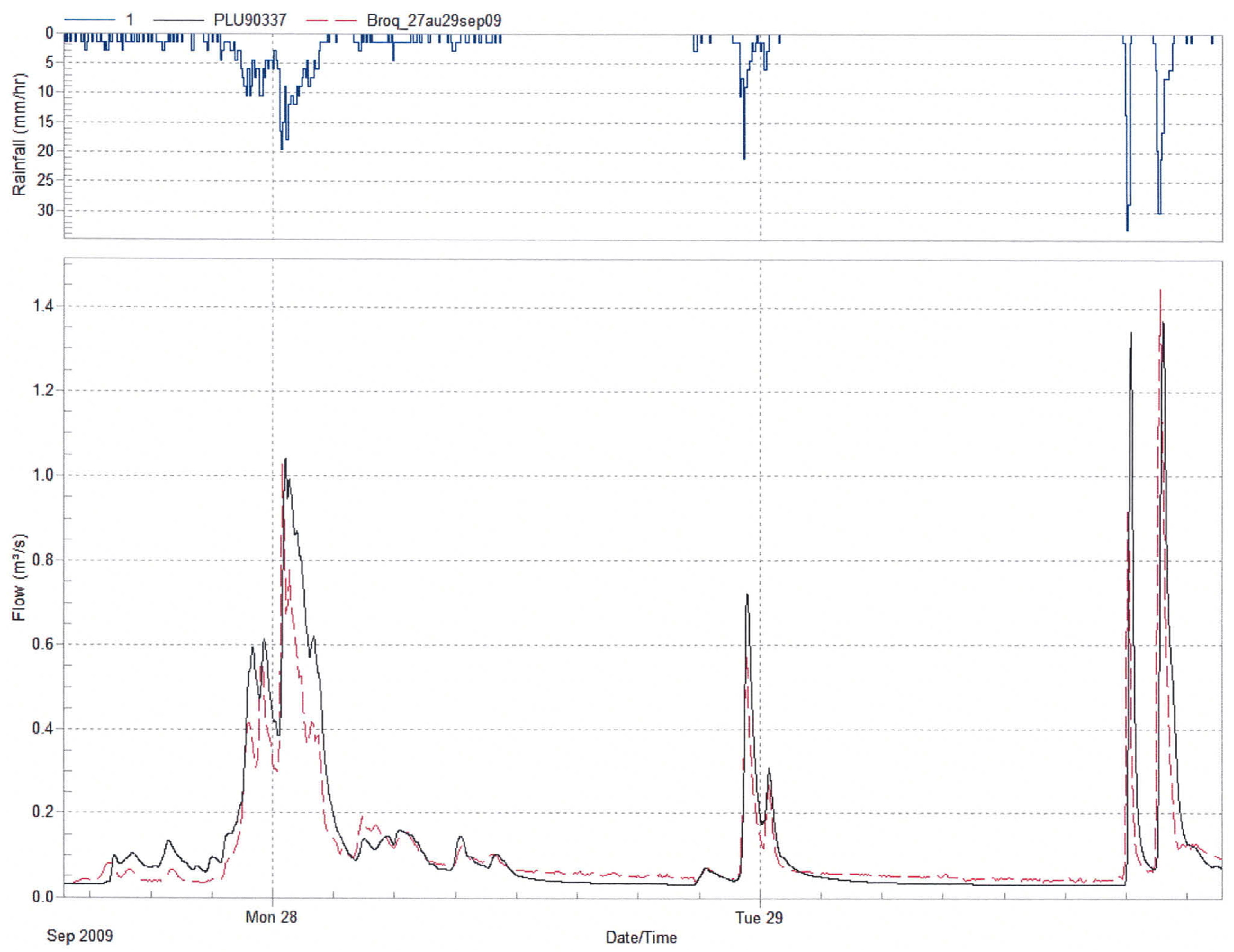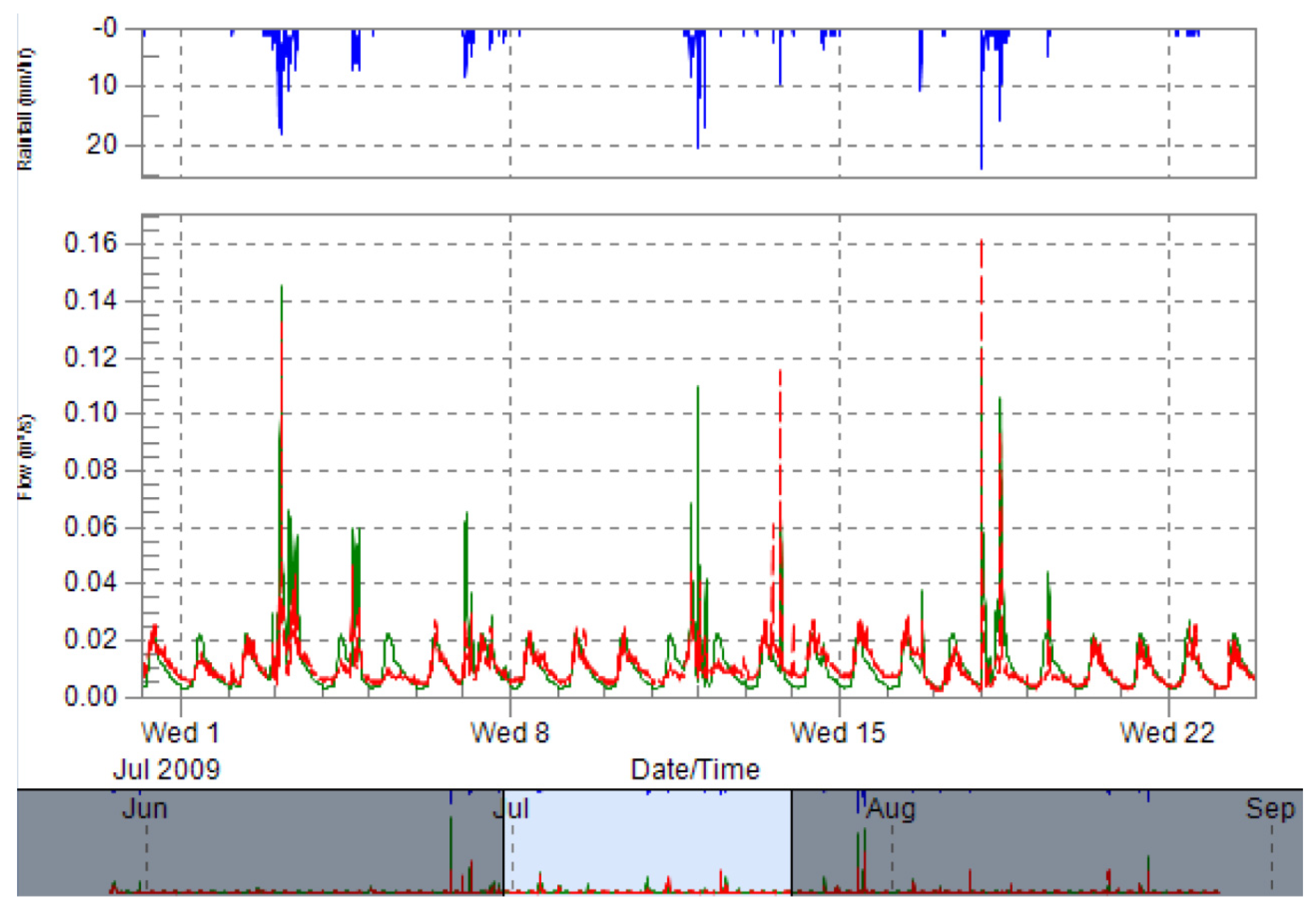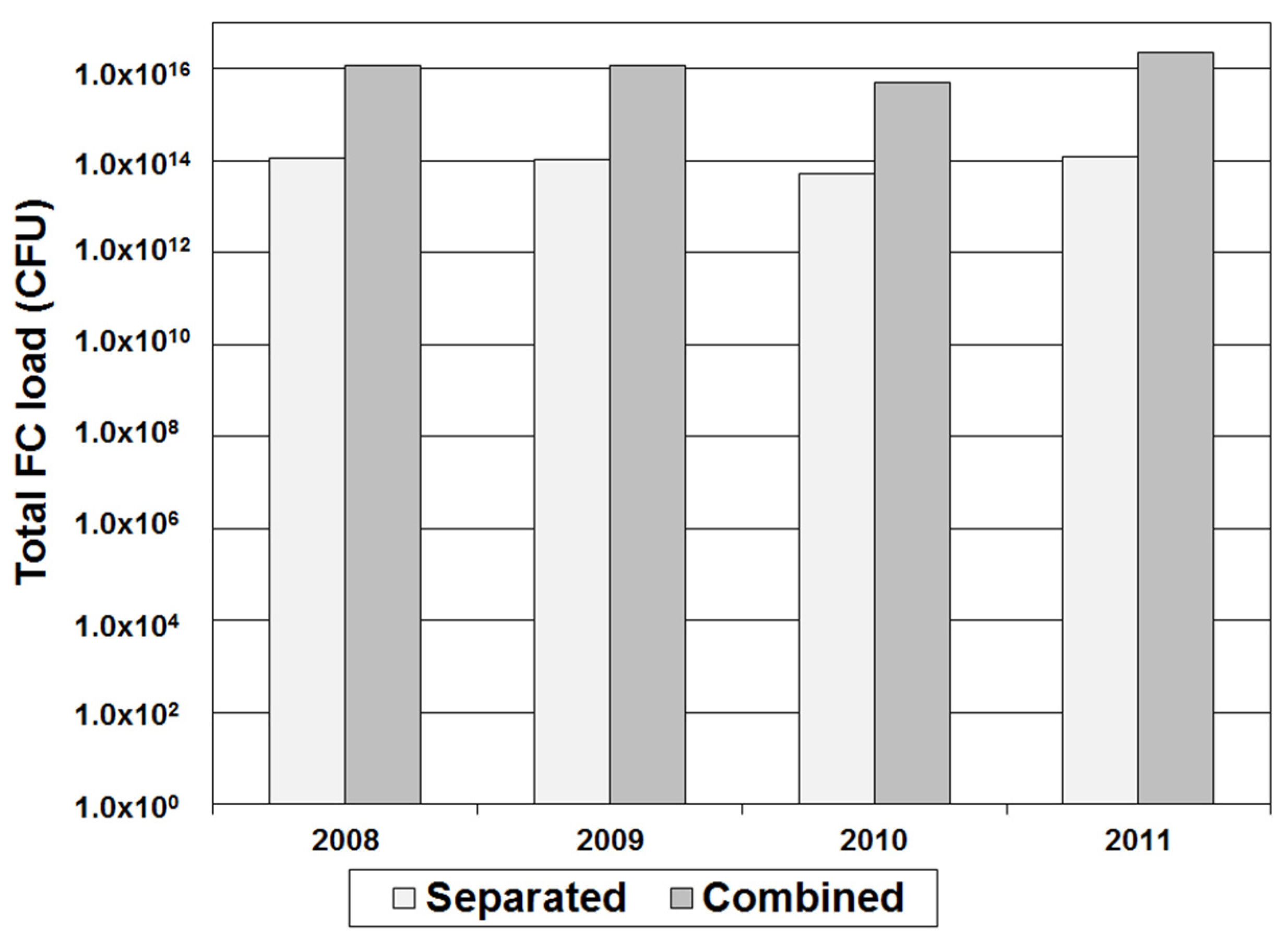2.1. Study Area
The Beauport River watershed is located in the Quebec City region (Canada) and covers an area of 28.7 km². The Beauport River flows through the watershed over a length of 22 km. The outlet of the river is situated in the Beauport Bay, a favored location for swimming and other secondary contact activities, such as fishing, kite surfing and kayaking. The area is divided into five large occupational classes: Residential, commercial, industrial, agricultural and undeveloped, which represent, respectively, 51%, 2%, 6%, 4% and 36% of the total area, as shown in
Figure 1. The different drainage systems and facilities are shown in
Figure 2. Precipitations were recorded every 5 min at the location shown in
Figure 2. Data concerning flow rates were available in the form of daily averages. The daily average flow rate from 2006 to 2011 was 0.74 m
3/s and the minimum recorded for those years was 0.18 m
3/s. Two types of drainage networks exist in the watershed. First, from the upstream to the center of the watershed, runoff is drained trough ditches and stormwater pipes that conduct flow to various watercourses, among which the Beauport River is the principal. Fifteen retention basins are located in this area of the watershed. Second, in the downstream part of the watershed (
i.e., in the subwatersheds illustrated in blue and green in
Figure 2), runoff is drained through combined sewer pipes. Combined sewer overflows (CSOs) can occur in this area during rainfall, as detailed in
Section 2.2.2.
Figure 1.
Land use in the Beauport River watershed.
Figure 1.
Land use in the Beauport River watershed.
Figure 2.
Separate (hollow) and combined (colored) subcatchments superposed with the location of the rain gauge, the river gauging station, the water quality sampling site and the combined sewer overflows (U051 and U057).
Figure 2.
Separate (hollow) and combined (colored) subcatchments superposed with the location of the rain gauge, the river gauging station, the water quality sampling site and the combined sewer overflows (U051 and U057).
2.3. Preliminary Statistical Analysis
To verify if a relationship existed between rainfall and FC concentrations in the Beauport River watershed, concentration data were divided into groups according to the total rainfall observed on the same day (day0) as the FC measurement, the day before (day−1) and two days before (day−2). An ANOVA test was performed to compare the geometric mean (GM) of FC concentrations observed on days with rainfall and without rainfall, at day0, day−1 and day−2. Days with and without rainfall were defined using two different thresholds, which are 0.1 and 5 mm. This means that, in a first analysis, days during which less than 0.1 mm of rainfall was recorded were considered without rainfall and, in second analysis, days were considered without rainfall if less than 5 mm of rainfall was recorded.
2.4. Comparison of Load Estimation Methods
FC loads coming from the Beauport River subwatersheds were computed using two different methods, namely the simple method and a method based on the simulation of hydrology and hydraulics. The first method, as stated by its name, has the advantage of being very simple to apply, but cannot be used in the area drained by a combined sewer network. Indeed, in this kind of network, a part of runoff is drained to the wastewater treatment plant, and this cannot be taken into account by the simple method. Also, as opposed to the second method, the simple method cannot be used to assess the impact of various intervention scenarios on the FC loads discharged to the Beauport River. For both methods, the fecal coliform loads were computed for the summer period, from 1 May to 31 August, for the four years under study.
The simple method (developed by Schueler [
9] and also used, among others, by the Center for Watershed Protection [
25]) provides and estimation of the order of magnitude of the pollutant loads produced by rainfall runoff in an urban area over a year. The total load for a given pollutant is computed using:
where:
L = annual load (M);
R = annual total runoff (L);
C = mean concentration (M/L
3);
A = drained area (L
2).
In the work presented here, the annual runoff (
R) was assessed with:
where:
P = annual precipitation (L);
RC = runoff coefficient.
The
RC values vary according to land use. For the Beauport River watershed, the values proposed by Brière [
26] were used (see
Table 3).
Table 3.
Runoff coefficients applied to the Beauport River watershed (from [
26]).
Table 3.
Runoff coefficients applied to the Beauport River watershed (from [26]).
| Land Use | Runoff Coefficient (RC) |
|---|
| Residential | 0.40 |
| Commercial | 0.70 |
| Industrial | 0.75 |
| Undeveloped | 0.10 |
| Agriculture | 0.15 |
As for the second method, the water volumes discharged to the river, from the separated and combined sewer networks, were computed using the USEPA SWMM model [
15]. For both methods, loads were then estimated by multiplying the discharged water volumes by the event mean concentrations (EMC) presented in
Table 4. For the stormwater outfalls, the selected EMCs are the median values proposed in [
27], except for the agricultural land use. For this land use as well as for the CSOs, the EMCs are the mean order of magnitudes issued from a broad literature review, including [
27,
28,
29,
30,
31,
32,
33].
Table 4.
Event Mean Concentrations (EMC) values for the different land uses.
Table 4.
Event Mean Concentrations (EMC) values for the different land uses.
| Source | EMC (CFU/100 mL) |
|---|
| Stormwater | Residential | 7,750 |
| Commercial | 4,500 |
| Industrial | 2,500 |
| Undeveloped | 3,100 |
| Agriculture | 10,000 |
| CSOs | 1,000,000 |
SWMM is a dynamic rainfall-runoff simulation model used for single events or long-term continuous simulation of runoff quantity and quality, primarily from urban areas. For the purpose of this study, the separate stormwater and combined sewer systems were modeled distinctly. Both of these SWMM models were previously calibrated and validated by the Quebec City’s Engineering Services department [
34,
35]. Some minor adjustments have also been brought to the models by the authors. More details are given in
Section 3.2.
Both SWMM models solve the St-Venant’s equations by dynamic wave routing and use Horton’s formula for infiltration. The different parameters of the models, established by the Quebec City’s Engineering Services department [
34,
35], are listed in
Table 5 and
Table 6.
Table 5.
Characteristics of the subcatchments in the SWMM models.
Table 5.
Characteristics of the subcatchments in the SWMM models.
| Physical Characteristics | Stormwater Model | Combined Model | Unit |
|---|
| Total area | 25.5 | 3.2 | km² |
| Number of subcatchments | 914 | 52 | – |
| Average slope of subcatchments | 2.0 | 2.0 | % |
| Average imperviousness | 31 | 76 | % |
| Conduit length | 91 | 23 | km |
| Beauport River length | 21.4 | – | km |
Table 6.
Parameters of the SWMM models.
Table 6.
Parameters of the SWMM models.
| Infiltration Model (Horton) |
|---|
| Maximal infiltration rate | 75–150 mm/h |
| Minimal infiltration rate | 2–15 mm/h |
| Infiltration rate decay | 0.001–4 h−1 |
| Manning Roughness Coefficient |
| Pervious surfaces | 0.25–0.28 |
| Impervious surfaces | 0.013–0.016 |
| Pipes | 0.013–0.3 |
2.5. Analysis of Scenarios
The objective of this analysis was to identify more efficient intervention methods to reduce the FC loads discharged to the Beauport River during and after rainfall events. To do so, the discharged FC loads were simulated according to six different scenarios, described below, for the 26 July 2011 rainfall event (from 0:00 to 23:55). Simulation of one day instead of a whole season allowed for a more precise analysis of the impacts of each scenario on the discharged FC loads, and the FC concentrations in the Beauport River. On 26 July 2011, a total of 33.9 mm of rainfall was recorded, with a maximal 5-min intensity of 25.2 mm/h (see hyetograph in
Figure 4). This event was chosen as it was the 21st in importance, in terms of total runoff as simulated with SWMM, for the 2008 to 2011 summers. This means that there were, on average, five events each summer that provided more FC loads to the Beauport River than the 26 July 2011 event.
Figure 4.
Recorded hyetograph on 26 July 2011.
Figure 4.
Recorded hyetograph on 26 July 2011.
To assess the FC concentrations in the Beauport River, a 0.36 m3/s base flow was added to the flow simulated by the SWMM stormwater model, since this model was elaborated, calibrated and validated to properly simulate urban drainage only; consequently, it does not integrate groundwater flow nor headwater lakes, that provide water to the Beauport River during the periods without rain. The selected value of 0.36 m3/s corresponds to the mean daily flow in the river the day before the simulated event, namely 25 July 2011, a day during which no rainfall occurred.
The six scenarios that were simulated are the following:
- (1)
Reference scenario (S1): Simulation of the watershed and drainage networks as they were in 2011.
- (2)
Retention scenario (S2): Similar to scenario 1, but with the addition of CSO retention tanks with sufficient capacities to contain all CSOs that occurred on 26 July 2011 (1935 m3 for unit U051 and 2772 m3 for unit U057, as simulated with SWMM).
- (3)
Primary treatment at some stormwater outfalls (S3): Similar to scenario 2, but with a proper retention time in the 15 stormwater retention basins already in place in the watershed, in order to achieve a 60% FC removal rate.
- (4)
Reduction of imperviousness (S4): Similar to scenario 2, but with a 1% decrease in the percentage of imperviousness for each subwatershed (meaning that the imperviousness of each subwatershed was multiplied by 0.99).
- (5)
Optimal management of stormwater (S5): Similar to scenario 2, but with a reduction in the EMC values for stormwater outfalls (respectively, 2500, 200, 500, 1.5 and 4.5 CFU/100 mL for the residential, commercial, industrial, agricultural and undeveloped land uses). These values are the minimal values observed by Wong ([
36], cited in [
27]). They correspond to EMCs that could be obtained with a very rigorous management of the urban surfaces and stormwater network, including correction of sewer cross connections, frequent road sweeping, regular cleaning of stormwater pipes, increase and promotion of infiltration,
etc.
- (6)
Compilation (S6): Compilation of all scenarios presented above.
